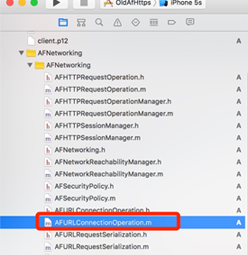自苹果宣布2017年1月1日开始强制使用https以来,htpps慢慢成为大家讨论的对象之一,不是说此前https没有出现,只是这一决策让得开发者始料未及,博主在15年的时候就做过https的接口,深知此坑之深,原因就是自身对这方面知识不了解加上网上的资料少,除此外还有博客不知对错就互相转载,导致当时网上几乎找不到能用的代码,这一点,博主说的毫不夸张。
鉴于此,博主一直想填一下这个坑,多增加一些正确的代码,来供广大开发者使用,后来一直被搁置,经过尝试后,博主现将整理好的代码发布在这里,希望能帮到焦急寻找的开发者。
1.先来说说老的AFNetworking2.x怎么来实现的 博主在网上看过几篇帖子,其中说的一些方法是正确的,但是却并不全对,由于那几篇博客几乎一样,博主不能确定最早的那篇是谁写的,所以就重新在下面说明下方法:
1)倒入client.p12证书;
2)在plist文件做如图配置:

3)在AFNetworking中修改一个类:

找到这个文件,在里面增加一个方法:
- (OSStatus)extractIdentity:(CFDataRef)inP12Data toIdentity:(SecIdentityRef*)identity { OSStatus securityError = errSecSuccess;CFStringRef password = CFSTR("证书密码"); const void *keys[] = { kSecImportExportPassphrase };const void *values[] = { password };CFDictionaryRef options = CFDictionaryCreate(NULL, keys, values, 1, NULL, NULL);CFArrayRef items = CFArrayCreate(NULL, 0, 0, NULL); securityError = SecPKCS12Import(inP12Data, options, &items);if (securityError == 0) {CFDictionaryRef ident = CFArrayGetValueAtIndex(items,0); const void *tempIdentity = NULL; tempIdentity = CFDictionaryGetValue(ident, kSecImportItemIdentity);*identity = (SecIdentityRef)tempIdentity;} if (options) {CFRelease(options);}return securityError;}再修改一个方法:
用下面的这段代码替换NSURLConnectionDelegate中的同名代码,
- (void)connection:(NSURLConnection *)connectionwillSendRequestForAuthenticationChallenge:(NSURLAuthenticationChallenge *)challenge{NSString *thePath = [[NSBundle mainBundle] pathForResource:@"client" ofType:@"p12"];//倒入证书NSLog(@"thePath===========%@",thePath);NSData *PKCS12Data = [[NSData alloc] initWithContentsOfFile:thePath];CFDataRef inPKCS12Data = (__bridge CFDataRef)PKCS12Data;SecIdentityRef identity = NULL;// extract the ideneity from the certificate[self extractIdentity :inPKCS12Data toIdentity:&identity];SecCertificateRef certificate = NULL;SecIdentityCopyCertificate (identity, &certificate);const void *certs[] = {certificate};//CFArrayRef certArray = CFArrayCreate(kCFAllocatorDefault, certs, 1, NULL);// create a credential from the certificate and ideneity, then reply to the challenge with the credential//NSLog(@"identity=========%@",identity);NSURLCredential *credential = [NSURLCredential credentialWithIdentity:identity certificates:nil persistence:NSURLCredentialPersistencePermanent];//credential = [NSURLCredential credentialWithIdentity:identity certificates:(__bridge NSArray*)certArray persistence:NSURLCredentialPersistencePermanent];[challenge.sender useCredential:credential forAuthenticationChallenge:challenge];}4)发起请求
NSString *url = @"xxxxxxxxxx";// 1.获得请求管理者AFHTTPRequestOperationManager *mgr = [AFHTTPRequestOperationManager manager];//2设置https 请求AFSecurityPolicy *securityPolicy = [AFSecurityPolicy policyWithPinningMode:AFSSLPinningModeCertificate];securityPolicy.allowInvalidCertificates = YES;mgr.securityPolicy = securityPolicy;// 3.发送POST请求[mgr POST:url parameters:nil success:^(AFHTTPRequestOperation * _Nonnull operation, id _Nonnull responseObject) {NSLog(@"responseObject: %@", responseObject);} failure:^(AFHTTPRequestOperation * _Nonnull operation, NSError * _Nonnull error) {NSLog(@"Error: %@", error);}];到此,老版的AFNetworking请求https接口的双向验证就做完了,但是有一个问题,这里需要改动AFNetworking的代码,何况新的AFNetworking已经有了,为了保持代码的活力,老的应该摒弃的,而且更新pods后肯定替换的代码就没了,也是一个问题,不要急,下面来说说怎么用新的AFNetworking,并解决被pods更新替换代码的问题。
最后再说一点,使用老的AF来请求,只用到了client.p12文件,并没有用到server.cer,在新的里面是有用到的,猜测可能是客户端选择信任任何证书导致的,就变成了单向的验证。
Demo放在最后
2.来说说新的AFNetworking3.x怎么来实现的1)倒入client.p12和server.cer文件
2)plist内的设置,这是和上面一样的:

3)这里可不需要修改类里面的代码,但是这里需要重写一个方法:
NSString *url = @"https://test.niuniuhaoguanjia.com/3.0.0/?service=City.GetCityList";NSString *certFilePath = [[NSBundle mainBundle] pathForResource:@"server" ofType:@"cer"];NSData *certData = [NSData dataWithContentsOfFile:certFilePath];NSSet *certSet = [NSSet setWithObject:certData];AFSecurityPolicy *policy = [AFSecurityPolicy policyWithPinningMode:AFSSLPinningModeCertificate withPinnedCertificates:certSet];policy.allowInvalidCertificates = YES;policy.validatesDomainName = NO;_manager = [AFHTTPSessionManager manager];_manager.securityPolicy = policy;_manager.requestSerializer = [AFHTTPRequestSerializer serializer];_manager.responseSerializer = [AFHTTPResponseSerializer serializer];_manager.responseSerializer.acceptableContentTypes = [NSSet setWithObjects:@"application/json", @"text/json", @"text/javascript",@"text/plain", nil];//关闭缓存避免干扰测试r_manager.requestSerializer.cachePolicy = NSURLRequestReloadIgnoringLocalCacheData;[_manager setSessionDidBecomeInvalidBlock:^(NSURLSession * _Nonnull session, NSError * _Nonnull error) {NSLog(@"setSessionDidBecomeInvalidBlock");}];//客户端请求验证 重写 setSessionDidReceiveAuthenticationChallengeBlock 方法__weak typeof(self)weakSelf = self;[_manager setSessionDidReceiveAuthenticationChallengeBlock:^NSURLSessionAuthChallengeDisposition(NSURLSession*session, NSURLAuthenticationChallenge *challenge, NSURLCredential *__autoreleasing*_credential) {NSURLSessionAuthChallengeDisposition disposition = NSURLSessionAuthChallengePerformDefaultHandling;__autoreleasing NSURLCredential *credential =nil;if([challenge.protectionSpace.authenticationMethod isEqualToString:NSURLAuthenticationMethodServerTrust]) {if([weakSelf.manager.securityPolicy evaluateServerTrust:challenge.protectionSpace.serverTrust forDomain:challenge.protectionSpace.host]) {credential = [NSURLCredential credentialForTrust:challenge.protectionSpace.serverTrust];if(credential) {disposition =NSURLSessionAuthChallengeUseCredential;} else {disposition =NSURLSessionAuthChallengePerformDefaultHandling;}} else {disposition = NSURLSessionAuthChallengeCancelAuthenticationChallenge;}} else {// client authenticationSecIdentityRef identity = NULL;SecTrustRef trust = NULL;NSString *p12 = [[NSBundle mainBundle] pathForResource:@"client"ofType:@"p12"];NSFileManager *fileManager =[NSFileManager defaultManager];if(![fileManager fileExistsAtPath:p12]){NSLog(@"client.p12:not exist");}else{NSData *PKCS12Data = [NSData dataWithContentsOfFile:p12];if ([[weakSelf class]extractIdentity:&identity andTrust:&trust fromPKCS12Data:PKCS12Data]){SecCertificateRef certificate = NULL;SecIdentityCopyCertificate(identity, &certificate);const void*certs[] = {certificate};CFArrayRef certArray =CFArrayCreate(kCFAllocatorDefault, certs,1,NULL);credential =[NSURLCredential credentialWithIdentity:identity certificates:(__bridge NSArray*)certArray persistence:NSURLCredentialPersistencePermanent];disposition =NSURLSessionAuthChallengeUseCredential;}}}*_credential = credential;return disposition;}];4)发起请求
//第三步和这一步代码是放在一起的,请注意哦[_manager GET:url parameters:nil progress:^(NSProgress * _Nonnull downloadProgress) {} success:^(NSURLSessionDataTask * _Nonnull task, id _Nullable responseObject) {NSDictionary *dic = [NSJSONSerialization JSONObjectWithData:responseObject options:NSJSONReadingMutableContainers error:nil];NSLog(@"JSON: %@", dic);} failure:^(NSURLSessionDataTask * _Nullable task, NSError * _Nonnull error) {NSLog(@"Error: %@", error);NSData *data = [error.userInfo objectForKey:@"com.alamofire.serialization.response.error.data"];NSString *str = [[NSString alloc]initWithData:data encoding:NSUTF8StringEncoding];NSLog(@"%@",str);}];另外还要加上一个方法:
+(BOOL)extractIdentity:(SecIdentityRef*)outIdentity andTrust:(SecTrustRef *)outTrust fromPKCS12Data:(NSData *)inPKCS12Data {OSStatus securityError = errSecSuccess;//client certificate passwordNSDictionary*optionsDictionary = [NSDictionary dictionaryWithObject:@"证书密码" forKey:(__bridge id)kSecImportExportPassphrase];CFArrayRef items = CFArrayCreate(NULL, 0, 0, NULL);securityError = SecPKCS12Import((__bridge CFDataRef)inPKCS12Data,(__bridge CFDictionaryRef)optionsDictionary,&items);if(securityError == 0) {CFDictionaryRef myIdentityAndTrust =CFArrayGetValueAtIndex(items,0);const void*tempIdentity =NULL;tempIdentity= CFDictionaryGetValue (myIdentityAndTrust,kSecImportItemIdentity);*outIdentity = (SecIdentityRef)tempIdentity;const void*tempTrust =NULL;tempTrust = CFDictionaryGetValue(myIdentityAndTrust,kSecImportItemTrust);*outTrust = (SecTrustRef)tempTrust;} else {NSLog(@"Failedwith error code %d",(int)securityError);return NO;}return YES;}没错,我们是要封装一下,可是要怎么封装呢?博主尝试了集中都失败了,真是百思不得解,相信主动去封装的开发者也会碰到封装后请求失败的问题,也许你成功了,但是这里需要注意一个在block内使用变量的问题,具体的可以去看博主怎么封装的。
到这里,新的AF请求https就已经结束了,想看封装的,Demo放在最后。
3.单向验证 说到这个,不得不说一下网上的很多方法,都把单向验证当作双向的,其实也是并不理解其原理,关于原理,请看这里
代码实现AF都是一样的:
//AF加上这句和下面的方法_manager.securityPolicy = [self customSecurityPolicy];/**** SSL Pinning ****/- (AFSecurityPolicy*)customSecurityPolicy {NSString *cerPath = [[NSBundle mainBundle] pathForResource:@"server" ofType:@"cer"];NSData *certData = [NSData dataWithContentsOfFile:cerPath];AFSecurityPolicy *securityPolicy = [AFSecurityPolicy policyWithPinningMode:AFSSLPinningModeCertificate];[securityPolicy setAllowInvalidCertificates:YES];NSSet *set = [NSSet setWithObjects:certData, nil];[securityPolicy setPinnedCertificates:@[certData]];/**** SSL Pinning ****/return securityPolicy;}4.Demo下载福利因为证书安全问题,Demo 里的证书博主删除了,请见谅,请大家放入自己的证书。
老的AF访问httpsDemo
新的AF访问httpsDemo
以上就是本文的全部内容,希望对大家的学习有所帮助,也希望大家多多支持脚本之家。


